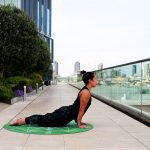Proper walking protects your neck

Walking comes so naturally to most of us that we may not even give a second thought to proper walking technique. But an improper gait can lead to a host of complaints, including a stiff neck. Some tips from Harvard Medical School on preventing neck pain
The good news is that it’s possible to correct decades of ingrained walking habits with a little work. In fact, even if you don’t think there’s anything wrong with your gait, you might benefit from the following tips:
Look ahead. Lift up from the top of your head. Don’t tuck your chin or look at the ground, but train your sights 10 to 20 feet ahead of you. If you need to check the ground to avoid obstacles, lower your eyes, not your head. An erect head reduces the likelihood of neck pain.
Stretch your spine. Your shoulders should be level and square, neither thrust back nor slumped forward. Tuck your buttocks in. When your body is in alignment, you should be able to draw an imaginary straight line from your ear through your shoulder, hip, knee, and ankle when viewed from the side.
Bend your arms. Flex your elbows at close to 90° angles and let your arms swing at waist level. Your fingers should be curled, but not clenched in a fist.
Swivel your hips. A slight pivot at the hip can add power to your stride.
Flex your feet. Come down on your heel; lift up off your toes. A person walking behind you should be able to see the sole of your shoe as you walk.
Take measured steps. Too long a stride throws you off balance. Concentrate on taking shorter steps, but more of them.
Share your load. Any load on the back or shoulders is likely to affect posture by thrusting the trunk forward. A backpack, which distributes weight evenly, is the best choice for carrying objects. If you use a shoulder bag, transfer it from one side to the other every few minutes as you walk.
Courtesy: Harvard Medical School















